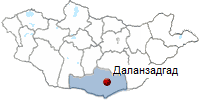Nemegt Formation. Geological formation in the Gobi Desert.
THE REGIONS OF MONGOLIA
UMNUGOBI AIMAG
NEMEGT GEOLOGICAL FORMATION


The Nemegt Formation (also known as Nemegtskaya Svita) is a geological formation in the Gobi Desert of Mongolia, dating to the Late Cretaceous.
The formation consists of river channel sediments and contains fossils of fish, turtles, crocodilians, and a diverse fauna of dinosaurs, including birds.
The Nemegt Formation is composed of mudstones and sandstones that were deposited by ancient lakes, streams, and flood plains. The Altan Uul locality was
described by Michael Novacek as "a canyon carved out of a very rich series of sedimentary rocks" with "steep cliffs and narrow washes". The climate
associated with it was wetter than when preceding formations were deposited; there seems to have existed at least some degree of forest cover.
Fossilized trunks have been also found. These petrified wood, and the remains of Araucariaceae conifers indicate that the forests of the
Nemegt were thickly wooded, with a high canopy formed by tall conifer trees. When examined, the rock facies of this formation suggest the
presence of stream and river channels, mudflats, and shallow lakes. Sediments also indicate that there existed a rich habitat, offering diverse
food in abundant amounts that could sustain massive Cretaceous dinosaurs.
- Nemegt canyon. Dry canyons south of Nemegt Mountain provide
interesting but strenuous hiking. Fossils, sometimes found on the surface,
should never be moved. Nemegt Uul. GPS: 43 40.00 N. 100 55.0 E
- Nemegt Mountain. Nemeht and Altan Mountains are located in the
territory of Curvan tes soum which are referred to be a homeland of dinasours.
Up until now dinasour fossils are found around these mountains. This soum has
many mountains famous for their beauties. There are more areas, which are
gorgeous such as Zuun mod, Zulganai, Mermen tsav, Naran, Naran daats, Khailaast
having fabulous rivers and oasis. These mountains located 400 kilometers away
from South govi province are rich with dinasour fossils. It is said that people
had manually excavated gold around 1900s and transported to China through the
China Mongolia border. The mountain is called Altan due to its untapped gold
resources. This mountain preserves footprints of ancient people who had
excavated gold. Eastern and western parts of Nemeht mountain used to be home for
mazaalai bears. However, mazaalai bears are becoming almost extinct.
- Nemegt Badlands. Sprawl below the southern slopes of Nemegt and Altan
Mountains. This is dinosaur country, where some of the world’s most dramatic
fossil discoveries nave been made. It’s also extremely rugged and remote. A trip
here requires self-sufficiency and careful planning. Beyond Nemegt Zulganai, an
oasis in the far west where poplar trees and reeds are supported by a small
river. In the northwest, near Ikh Bayan Mountain. Bichiegt Valley Is rich in
petroglyphs. The area is best approached from Bayankhongor, on the north side.
Guides are available through the Bichegt community
- Sevrei Mountain. The road west from Sevrei runs along the base of
Sevrei Mountain /2631 m/, one of the highest peaks in the Gobi
INFORMATION:
PAGES OF THE PICTURE ALBUM
|